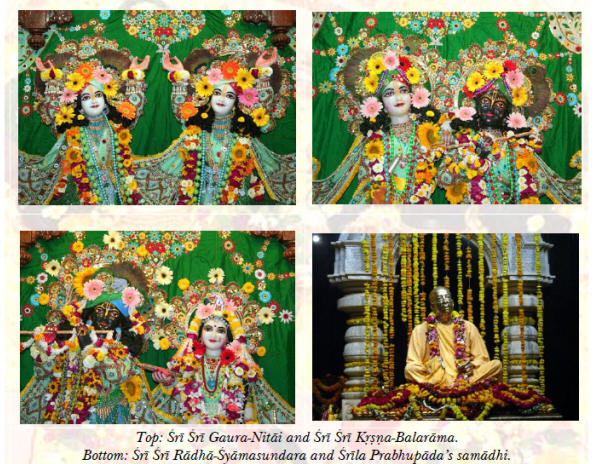“Here I am now sitting in New York, the world’s greatest city, but my heart is always hankering after that Vrindavan. I shall be very happy to return to my Vrindavan, that sacred place.”
Srila Prabhupada (lilamrita)

In Brahma-samhita, the transcendental land of Vrindavana is described as being always spiritual. That spiritual land is populated by thousands of goddesses of fortune, who are known as gopis. The trees of that land are kalpa-vrksa, wish-fulfilling trees, and one can have anything one wants from them. The land is made of touchstone and the water of nectar. In that land, all speech is song, and all walking is dancing.
An expansion of this Vrindavana, which is the supreme abode of Krishna, is also present on this earth, and superior devotees worship this place as the supreme abode. However, no one can appreciate Vrindavana without being highly elevated in spiritualknowledge. According to our ordinary experience, Vrindavana appears to be just likean ordinary village, but in the eyes of a highly elevated devotee, it is as good as the original Vrindavana. The human form of life is meant for understanding this transcendental land of Vrindavana, and one who is fortunate should cultivate knowledge of Vrindavana and its residents.
Qualification and the medium to enter the Holy dhama
Srila Bhaktivinoda Thakura has given an example of what one can feel while performing parikrama of a dhama, “When Lord Nityananda took Jiva Gosvami for a Navadvipa parikrama, it was a real transcendental experience. While having kirtana, they were dancing, rolling on the ground and crying in ecstasy. Sometimes, Lord Caitanya appeared with all His associates.”
One cannot enter into the dhama just by buying a ticket or by physical presence. One has to be qualified by the purity of the heart and must always carry the right mood. The right mood is to pray to the Holy dhama, pray to the saintly persons residing there to bestow their blessings, to reveal and to share the transcendental nature of the Holy dhama with us. That means even if one is not present there physically, one can enter Vrindavana. The real ticket to Vrindavana dhama is the sound vibration and one should receive those vibrations with a humble heart.”

Rare opportunity to associate with pure sound vibrations:
The entirety of transcendental knowledge is accessed by hearing the name and praise of the Lord in association with like-minded souls. This enhances transcendental affection for Krishna.” In Srimad Bhagavatam (4.20.24), Maharaja Prthu prays, “My dear Lord, I want the benediction of at least one million ears, for thus I may be able to hear about the glories of Your lotus feet from the mouths of Your pure devotees.”
Sri Vraja-mandala Parikrama
Srimad-Bhagavatam(10.21.10)
Vrindavanam sakhibhuvovitanotikirtim
yaddevaki-suta-padambuja-
govinda-venumanumatta-mayura-
preksyadri-sanv-avaratanya-
“O sakhi, the fame of the earth is enhanced, having been decorated with the marks of Sri Krishna’s lotus feet. Upon hearing Krishna’s flute song, peacocks take it to be thunder of clouds and becoming intoxicated, begin to dance. When the other animals in the meadows of Govardhana see this, they are mesmerized. Thus, the presence of Sri Vrindavana on earth makes this planet even more glorious than Vaikuntha.”
Vraja-mandala extends for about 168 miles (84 kosas).
Garga-samhita (khanda 2) states:
pragudicyambahirsado
daksinasyamyadohpurat
pascimayamsonitapuran
mathurammandalamviduh
“That land between Bahirsad (Barhada) in the north-east,Yadupura (the village Batesvara of Surasena) in the south and Sonitpura (Sonhada) in the west, which measures 84 kosas, has been called Mathura-mandala or Vraja, bylearned persons.”
Bara is situated in the present district of Aligarh in the north-east corner of Vraja-mandala. Sonhada is located in the district of Gurgaon in the state of Harayana, which is in the north-west corner of Vraja mandala. Its ancient name is Sonitpura. The village of Surasena is the village of Batesvara in the revenue district of Baha. The area between these places is called Vraja-mandala.
The borders of Vraja-mandala are also mentioned in the Brahmanda Purana. According to this Purana, Hasyavana lies in the east of Vraja-mandala, Janhuvana in the south, Parvatavanain in the west and Suryapattanavana in the north. Corresponding to this description, Hasanagadha of the Agra district, which lies in the east, is known as Hasyavana; in the west, Bahadi-grama near Kamyavana in Rajasthana is known as Parvatavana; in the south, Jajau-grama of the Dhaulapura revenue district is famous as Janhu and in the north, near Jevara-grama of the Aligarh district, lies Suryapattanavana.
In the eighty-four kosas of Vraja-mandala, there are 48 forests (vanas), which include upavanas (sub-forests), prativanas and adhivanas. According to the Padma Purana, there are 12 principal forests situated east and west of the Yamuna.
These are (1) Mahavana, (2) Kamyavana, (3) Madhuvana, (4) Talavana, (5) Kumudavana, (6) Bhandiravana, (7) Vrindavana, (8) Khadiravana, (9) Lohavana, (10) Bhadravana, (11) Bahulavana and (12) Baelvana. Of these 12 forests, seven lie on the west of the Yamuna – Madhuvana, Talavana, Kumudavana, Bahulavana, Kamyavana, Khadiravana and Vrindavana. The remaining five – Bhadravana, Bhandirvana, Baelvana, Lohavana and Mahavana – are situated on the eastern side of the Yamuna.
The Varaha Purana mentions 12 upavanas: (1) Brahmavana, (2) Apsaravana, (3) Vihvalavana, (4) Kadambavana, (5) Svarnavana, (6) Surabhivana, (7) Premavana, (8) Mayuravana, (9) Manengitavana, (10) Sesasayivana, (11) Naradavana and (12) Paramanandavana.
The Bhavisya Purana mentions the following 12 prativanas: (1) Rankavana, (2) Varttavana, (3) Karahavana, (4) Kamavana, (5) Anjanavana, (6) Karnavana, (7) Krishnaksipanavana, (8) Nandapreksana Krishnavana, (9) Indravana, (10) Siksavana, (11) Candravalivana and (12) Lohavana.
Finally, the Visnu Purana describes the following 12 adhivanas: (1) Mathura, (2) Radha-kunda, (3) Nandagaon, (4) Gadha, (5) Lalita-grama, (6) Vrsabhanupura, (7) Gokula, (8) Balabhadravana, (9) Govardhana, (10) Javata, (11) Vrindavana and (12) Sanketvana. This adds up to a total of 48 forests.